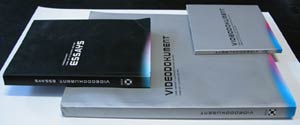Thirty Years of Slovene Video
Videodokument: Video Art in Slovenia 1969-1998, edited by Barbara Borèiæ, Open Society Institute, Ljubljana, 1999
(review)
 Many catalogues have been published recently about video art and its history. When reading them, one wonders if they are meant to announce the end of video as an art form, which has fulfilled its artistic and technological purpose and is now ready to be replaced with the latest advancements in digital technology. Although one of the essays in the publication Videodokument foresees this end, it is not concerned with speculating about obscure theories. Instead, it intends to document the past thirty years of Slovene video with the aim of preserving it for future research. The editors created a specialized textbook for (future) specialists who can rely on it when researching and analyzing contemporary video art.
Many catalogues have been published recently about video art and its history. When reading them, one wonders if they are meant to announce the end of video as an art form, which has fulfilled its artistic and technological purpose and is now ready to be replaced with the latest advancements in digital technology. Although one of the essays in the publication Videodokument foresees this end, it is not concerned with speculating about obscure theories. Instead, it intends to document the past thirty years of Slovene video with the aim of preserving it for future research. The editors created a specialized textbook for (future) specialists who can rely on it when researching and analyzing contemporary video art.
In the catalouge, we find an endless list of artists' projects, published texts, exhibitions, performances and lectures, conference and media appearances, etc. and the articles published about them. This data flow may well confuse the ordinary reader who is interested in one specific field of art. However, such researchers may be interested in the CD-ROM. This publication by SCCA (Soros Center for Contemporary Art) consists of three parts: a large-size colour catalogue, a small black and white volume of essays and a CD-ROM. The latter in clude s parts of the catalogue and all the essays, complete with one video clip by each artist.
These extracts are incredibly short (probably due to the CD's limited storage capacity) but long enough to give us a taste of the multitude of genres and artistic expressions that developed under the title Video; which, in the beginning, showed documentary qualities and only in the late eighties became what we know it today: a medium verging at the edge between fine art and film. When watching the videos one inevitably notices that the choice of clips is biased, the editors obviously preferred the eighties and nineties to the seventies.
What disturbed me most however, was the structure and organization of the CD-ROM. Since the units on the multimedia surface are not inter linked with one another, one cannot directly enter, from a video clip, the file of the artist or the essays that discuss him or her. Additionally, the essays often fail to discuss the artists in detail. The authors settle for the description of the spirit of the decade and the artistic background probably assuming that it is the researcher's task to set an artist in context. The essays do, however, give us an overall view and a good understanding of the thirty years of Slovene video.
(Ágnes Ivacs)